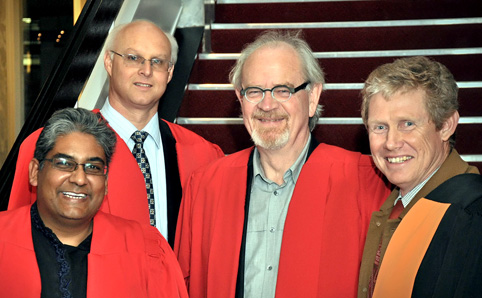|

|
|
Present at the CR Swart Memorial Lecture was, from the left: Prof. Hussein Solomon, senior Professor in our Department of Political Science; Prof. Theo Neethling, Head of our Department of Political Science; Max du Preez and Prof. Lucius Botes,Dean of our Faculty of Humanities.
Photo: Stephen Collett
|
“Much has been going wrong in South Africa in the last few years and it’s all due to a lack of strong, visionary leadership. South Africans deserve better and should demand more integrity, courage and vision from the present political leadership,” veteran journalist and author Max du Preez told the audience at a packed Wynand Mouton Theatre at our university, on 25 August 2011.
Delivering this year’s CR Swart Memorial Lecture on the topic “Of Jacob, Julius, Jimmy and the Dancing Monkey”, Du Preez told the audience to look with much more critical eyes at the political leadership and decide who is doing the obvious, following his or her basest instincts or simply trying to play to the gallery. “Why look at a man like Julius Malema and let him upset us, why listen to Floyd Shivambu with his crude manners and let them define us?” Du Preez asked the more than 300 people attending the memorial lecture. The CR Swart Memorial Lecture, the 41st hosted by the UFS, attracted one of the largest crowds ever for a public lecture, with some people sitting on the steps inside the auditorium of the Wynand theatre.
Telling the story of African philospher Morena Mohlomi, who acted as a teacher to Basuto king Moshoeshoe, Du Preez told the audience that the country needs counter-intuitive leadership like the two leaders had demonstrated. Calling Mohlomi southern Africa’s first Pan Africanist, Du Preez said the extroadinary thing about Morena Mohlomi and his student was their gift of counter-intuitive leadership, leadership that was daring and visionary, leadership that did not simply do the obvious. Pointing out other visionary leaders like Nelson Mandela, Oliver Tambo, Walter Sisulu, Beyers Naude and Van Zyl Slabbert, Du Preez urged the audience to question “the quality of leadership of Cosatu, the Democratic Teachers Union that is messing up our education, the Communist Party, the Democratic Alliance, the Freedom Front Plus and Solidarity. If they don’t live up to our expectations, why do we still tolerate them?” Du Preez asked.
Du Preez also commended Prof. Jonathan Jansen, Vice Chancellor and Rector of the UFS, for his counter-intuitive leadership regarding the Reitz Residence incident and said Prof. Jansen’s solution, as controversial as it was, brought a much better outcome.
Please find
attached the full speech of Max Du Preez.